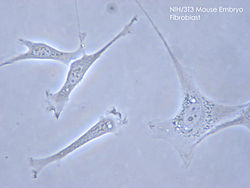Fibroblast
| Fibroblast | |
|---|---|

|
|
| Details | |
| Identifiers | |
| Latin | fibroblastus |
| Code | TH H2.00.03.0.01002 |
|
Anatomical terminology
[]
|
|
A fibroblast is a type of cell that synthesizes the extracellular matrix and collagen, the structural framework (stroma) for animal tissues, and plays a critical role in wound healing. Fibroblasts are the most common cells of connective tissue in animals.
Fibroblasts and fibrocytes are two states of the same cells, the former being the activated state, the latter the less active state, concerned with maintenance and tissue metabolism. Currently, there is a tendency to call both forms fibroblasts. The suffix "-blast" is used in cellular biology to denote a stem cell or a cell in an activated state of metabolism.
Fibroblasts are morphologically heterogeneous with diverse appearances depending on their location and activity. Though morphologically inconspicuous, ectopically transplanted fibroblasts can often retain positional memory of the location and tissue context where they had previously resided, at least over a few generations. This remarkable behavior may lead to discomfort in the rare event that they stagnate there excessively.
The main function of fibroblasts is to maintain the structural integrity of connective tissues by continuously secreting precursors of the extracellular matrix. Fibroblasts secrete the precursors of all the components of the extracellular matrix, primarily the ground substance and a variety of fibers. The composition of the extracellular matrix determines the physical properties of connective tissues.
Like other cells of connective tissue, fibroblasts are derived from primitive mesenchyme. Thus they express the intermediate filament protein vimentin, a feature used as a marker to distinguish their mesodermal origin. However, this test is not specific as epithelial cells cultured in vitro on adherent substratum may also express vimentin after some time.
...
Wikipedia
